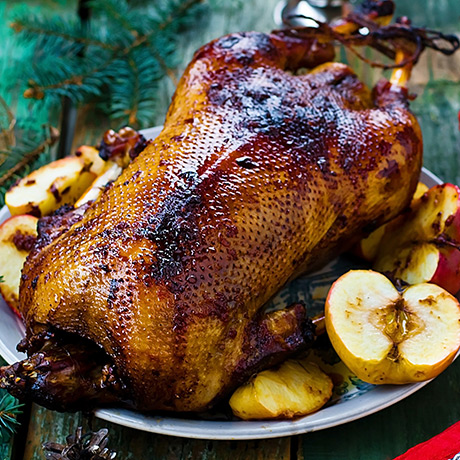All About Goose

The tradition of eating goose at winter solstice dates back to the Middle Ages in Europe and Central Asia, and roast goose is still part of Christmas celebrations in Germany, Central Europe and Scandinavia.
There are many species of goose, all with varying sizes. Some small species are bred for their tender meat and usually weigh between 3 and 5 pounds. Others are bred for their foie gras; these are generally grown to 10 to 12 pounds, when their liver weighs up to 1 pound.
Goose is delicious with bittersweet ingredients and a range of fruits and nuts. Try it with spices such as star anise, juniper berries, cinnamon, cardamom and cloves, or herbs such as bay leaves, rosemary, savoury, sage or thyme. Cherries, strawberries, oranges or apples add a hint of fresh tartness to the rich meat, and goose with chestnuts is a classic pairing. For more flavour, roast or simmer goose in white wine or dry cider.
Cooking methods

Roasted goose
Roasting is perfect for goose because it allows you to reduce the amount of fat in the fowl. This is achieved by pricking the skin with a fork prior to roasting in the oven or cooking in a rotisserie.
- Remove the excess fat around the Parson’s nose.
- Rub the skin with lemon.
- Stuff the cavity.
- Pull back any excess skin and fold inside
- Truss the goose.
- Pierce the skin (not the meat) all over to allow the goose fat to seep out.
- While cooking, the aroma of the stuffing will permeate the meat and the skin will become golden-brown and crispy.
- Place the goose on the rack of a roasting pan in the oven or in a rotisserie.
- Roast for 30 minutes per kilo (2.2 pounds) at 160°C (320°F).
- Baste the goose every 15 minutes, until the skin is golden brown.
- Once cooked, place the goose on a carving board and wrap loosely with foil, allowing steam to escape. Let stand for 15 minutes before serving.
Tips and advice
- Goose can be cooked like duck, turkey and chicken.
- A great European classic is hazelnut-stuffed goose, served with potatoes or sauerkraut.
- The meat of an older or very big goose can be turned into confits, pâtés and rillettes. It can also be braised or stewed.
- Goose fat can be used like butter. Try it on roasted potatoes for a crispy, decadent treat.
- To decrease the amount of fat in a goose, prick the skin in several places before cooking. Place it in a roasting pan and turn it over midway through cooking. Skim off the fat from the sauce.
- Foie gras is the liver of a force-fed goose or duck. To learn more about foie gras, visit our All About Liver story.
Nutritional value
The nutritional value of goose is similar to duck: rich in iron and vitamin B. It does, however, have a higher fat content.
Storage
Goose should not be stored in the refrigerator longer than 48 hours.
Goose cuts and whole goose with giblets removed can be stored in the refrigerator, tightly wrapped in plastic then in foil to preserve flavour.
To freeze goose, place it in a well-sealed freezer bag or wrap tightly in plastic then in foil.
There are several ways to defrost a goose. The safest method is to defrost it in the refrigerator. Allow 10 to 11 hours per kilo (5 to 6 hours per pound). Leave the goose in its freezer packaging, making a few holes at the bottom to allow the liquid to drain out and away from the bird.
A goose can also be defrosted in cold water. Allow 2 hours per kilo (1 hour per pound) and change the water frequently.
A defrosted goose must be cooked within 48 hours. Never re-freeze defrosted goose.







